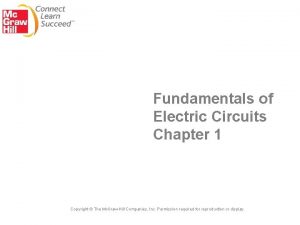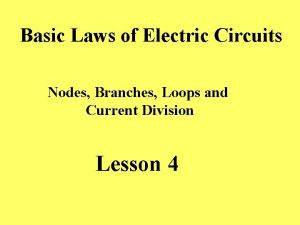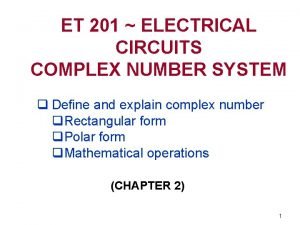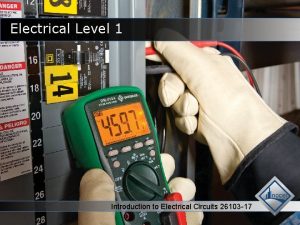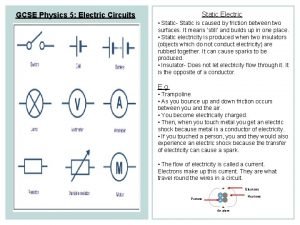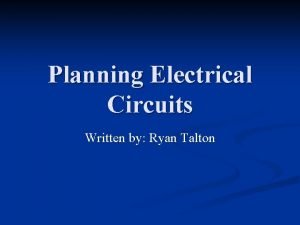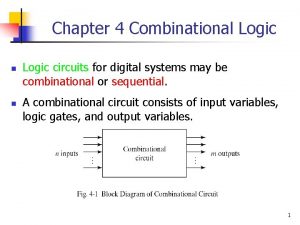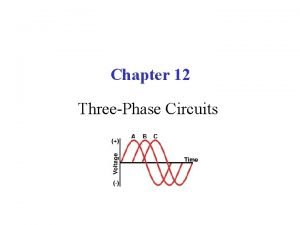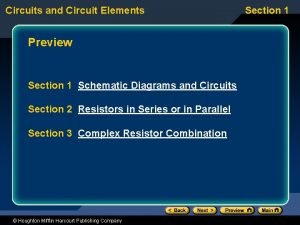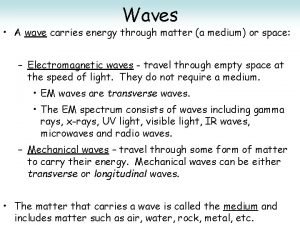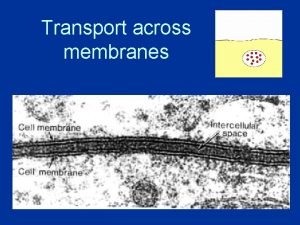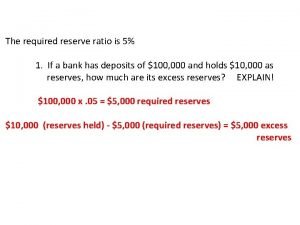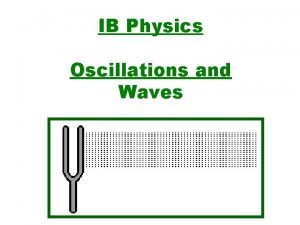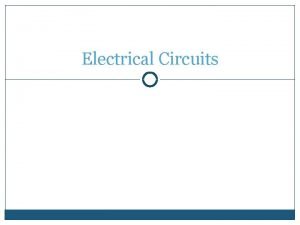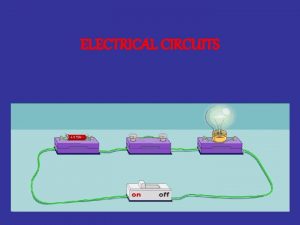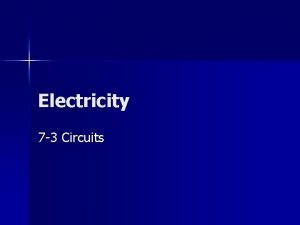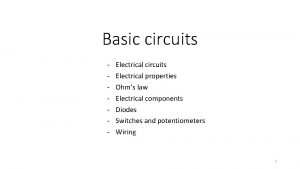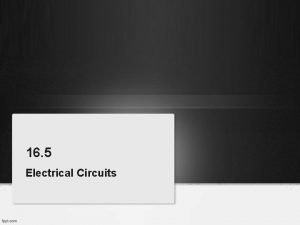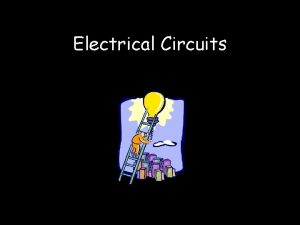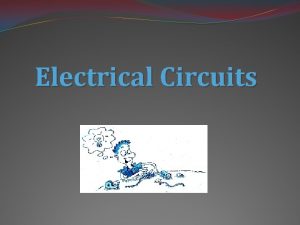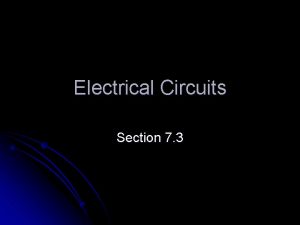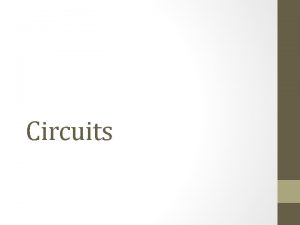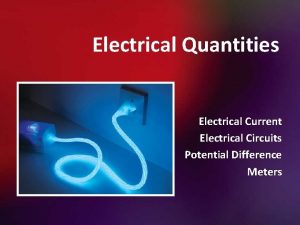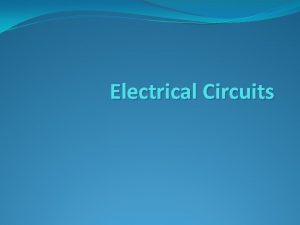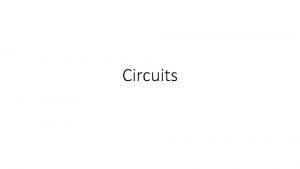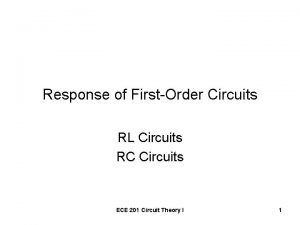All electrical circuits require three elements 1 A


![ELECTRONS INTO LOAD (RESISTANCE) [ENERGY OUT] ELECTRONS OUT OF LOAD CONDUCTOR ELECTRONS OUT OF ELECTRONS INTO LOAD (RESISTANCE) [ENERGY OUT] ELECTRONS OUT OF LOAD CONDUCTOR ELECTRONS OUT OF](https://slidetodoc.com/presentation_image/c249fa3e9830d393ad4e0cfc20fc965f/image-3.jpg)

















- Slides: 20


All electrical circuits require three elements. (1) A source voltage, that is, an electron pump usually (2) a battery or power supply. (3) [ ENERGY IN] (2) A conductor to carry electrons from and to the voltage source (pump). The conductor is often a wire. [ENERGY TRANSFER] (3) A load or resistance. A point where energy is extracted form the circuit in the form of heat, light, motion, etc. [ENERGY OUT]
![ELECTRONS INTO LOAD RESISTANCE ENERGY OUT ELECTRONS OUT OF LOAD CONDUCTOR ELECTRONS OUT OF ELECTRONS INTO LOAD (RESISTANCE) [ENERGY OUT] ELECTRONS OUT OF LOAD CONDUCTOR ELECTRONS OUT OF](https://slidetodoc.com/presentation_image/c249fa3e9830d393ad4e0cfc20fc965f/image-3.jpg)
ELECTRONS INTO LOAD (RESISTANCE) [ENERGY OUT] ELECTRONS OUT OF LOAD CONDUCTOR ELECTRONS OUT OF SOURCE HIGHER ENERGY ELECTRONS ELECTRON PUMP (SOURCE VOLTAGE) [ENERGY IN] ELECTRONS BACK TO SOURCE LOWER ENERGY ELECTRONS

High Energy current Resistance (Potential Drop) Voltage Source (Potential Rise) Low Energy current

volts current Electrons have More Energy Battery Electrons get An energy boost current Electrons have Less Energy

volts Resistor Electrons have Less Energy is lost In the resistor current Electrons have More Energy

(1) VOLTAGE RISE – MEASURES THE ENERGY GIVEN TO ELECTRONS AS THEY LEAVE A VOLTAGE SOURCE. IT IS MEASURED IN VOLTS (+) (2) VOLTAGE DROP – MEASURES THE ENERGY LOST BY TO ELECTRONS WHEN THEY LEAVE A RESISTANCE. IT IS MEASURED IN VOLTS (-) (3) CURRENT – MEASURES THE FLOW RATE THROUGH A CONDUCTOR. IT IS MEASURED IN AMPERES (AMPS) (4)RESISTANCE – MEASURES THE OPPOSITION TO CURRENT FLOW THROUGH A CONDUCTOR OR RESISTOR IT IS MEASURED IN OHMS (ITS SYMBOL IS OMEGA )

ELECTRICAL QUANTITIES 6. 25 x 10 18 electrons 1 coulomb 1 joule 1 second 1 amp = 1 coul / sec 1 volt = 1 joule / coul 1 coulomb of charge

AMPS volts Ammeters measure current in amperes and are always wired in series in the circuit. Voltmeters measure potential in volts and are always wired in parallel in the circuit.



battery - + wiring voltmeter ammeter junction terminal V A AC generator Variable resistance capacitor Variable capacitor

Measure electrical quantities in an electrical Circuit are related to eachother by: OHM’S LAW says, if the source voltage remains constant, increasing the resistance in a circuit will cause a decrease in current flow in that circuit. In mathematical terms it tells us that current flow is inversely proportional to resistance. In equation form it says: Voltage (V) = Current (I) x Resistance (R) or V(in volts) = I (in amps) x R (in ohms)

Potential In volts (joules / coul) Current In amperes (coul / second) Drop across a resistance Current passing Through the resistor Resistance In ohms (volts / amp)

The slope of the Line gives the resistance V O L T A G E v (volts) R = v / I or rearranged v = I x R Current (I) in amps I

All voltage sources contain internal resistance, that is resistance that is part of the voltage producing device itself which cannot be eliminated. The voltage that the device (battery for example) could produce if no internal resistance was present is called its EMF stands for electromotive force – the force that moves the electrons. The useable voltage which is available to the circuit after the internal resistance consumes its share of the EMF is called The terminal voltage.

EMF Voltage rise + Voltage drop EMF of Source Terminal voltage Internal resistance - conventional current flow

Since voltage rise across a source or Voltage drop across a resistance can be Calculated by Ohm’s Law V= IR And the above equation becomes V terminal = EMF – I x R internal Note that if R internal is very small then a large Percentage of the EMF is available to the circuit. Also note that if I, the current is very large then a large percentage of the EMF is consumed within the battery itself which can cause overheating and failure. This is generally the result of a short circuit.

Net Voltage Rise of cell (Terminal Voltage volts current Ri -V Voltage drop Due to internal resistance Battery EMF current +V Voltage rise Due to EMF

 What are the three elements of electricity
What are the three elements of electricity Types of elements in electrical circuits
Types of elements in electrical circuits Advantages of parallel circuits over series circuit
Advantages of parallel circuits over series circuit Type of circuits
Type of circuits Nodes in electrical circuit
Nodes in electrical circuit 14-13
14-13 Nccer introduction to electrical circuits
Nccer introduction to electrical circuits Electrical circuits gcse
Electrical circuits gcse Planning electrical circuits
Planning electrical circuits Name all the lines name all the segments name all the rays
Name all the lines name all the segments name all the rays Table of 32
Table of 32 Positive phase sequence
Positive phase sequence Circuits and circuit elements
Circuits and circuit elements Mechanical waves and electromagnetic waves similarities
Mechanical waves and electromagnetic waves similarities Wave medium
Wave medium It monitor users behavior and offer contextual advice
It monitor users behavior and offer contextual advice Does exocytosis require energy
Does exocytosis require energy Required reserve ratio
Required reserve ratio How far down is the title page in apa
How far down is the title page in apa Does simple diffusion require energy
Does simple diffusion require energy Toh
Toh

